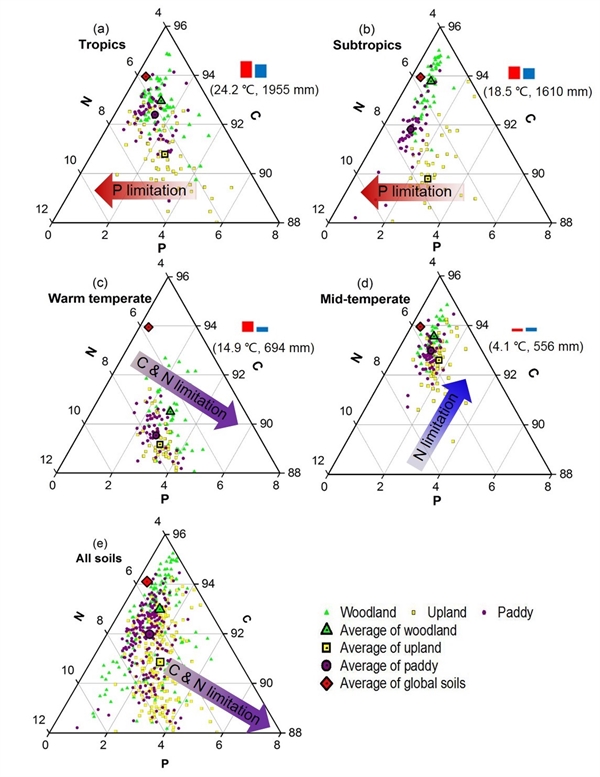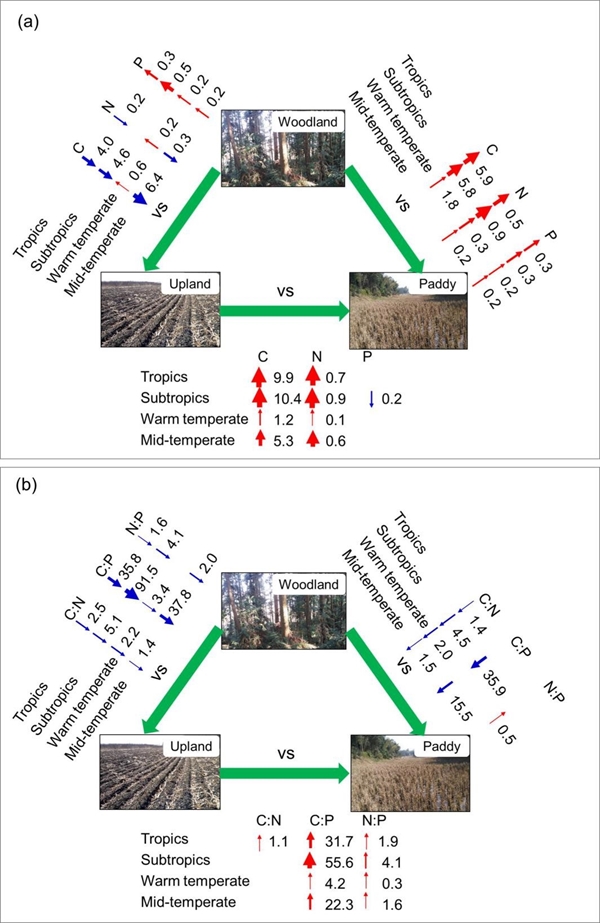Study Reveals How C:N:P Stoichiometry Responds to Agricultural Land Use and Climate
Carbon (C), nitrogen (N), and phosphorus (P) are three bioelements with maximal accumulations in areas of abundant life. C:N:P stoichiometry in soils greatly determines nutrient availability for plants and soil microorganisms, and further reflects the functioning of terrestrial ecosystems.
Soil C:N:P ratios are very susceptible to human activities (e.g., fertilization) and climate factors (e.g., temperature and precipitation). However, how the soil C:N:P stoichiometry is affected by upland and paddy cropping over broad geographical scale remains largely unknown.
A research group led by Prof. SU Yirong from the Institute of Subtropical Agriculture (ISA) of the Chinese Academy of Sciences conducted a study to examine the soil C:N:P stoichiometry in woodland (as control), agricultural upland and paddy from four climate zones (tropics, subtropics, warm temperate, and mid-temperate) across eastern China. The study was published in Soil and Tillage Research on Dec. 30.
The researchers collected 720 surface soil samples from 240 sites with adjacent woodland, agricultural upland, and paddy at a depth of 0-15 cm. Total C, N, and P contents and their ratios were determined.
They found that among climate zones, C and N contents and C:N ratios decreased in the order of mid-temperate > tropics > subtropics > warm temperate, whereas C:P and N:P ratios followed the order of subtropics > mid-temperate and tropics > warm-temperate.
"Compared to woodland, upland agriculture decreased the C content, but increased P content, resulting in the decreases of C:N, C:P, and N:P ratios. Hence, uplands are relatively limited by C and N but enriched with P, particularly in warm temperate zone," said Prof. SU.
By contrast, the C, N, and P contents in paddy soils were all increased compared to woodland soils, but larger N and P increase leads to the decreases in C:N and C:P ratios. The higher P content, and consequently lower C:N:P ratios in both agricultural soils are the consequences of intensive fertilization.
As a whole, the direction of soil C, N, and P contents and their stoichiometric ratios in response to agricultural use was similar in the four climate zones: P increased, but C:N:P ratios decreased. The effects of agricultural use on C:N:P stoichiometry were greater in warmer and wetter zones.
This study provides a comparable dataset on the alteration of soil C, N, and P balances in the main Chinese grain-producing areas subjected to long-term intensive cultivation, which is useful to optimize future agricultural management.
Contact: Chen Xiangbi
E-mail: xbchen@isa.ac.cn
Institute of Subtropical Agriculture, Chinese Academy of Sciences

Fig. 1. Ternary plots of C:N:P (based on original C:N:P molar data) for three land-use types among each of the four climate zones (a-d) and all soils (e). (Image by ZHENG Shengmeng)

Fig. 2. Differences in C, N, and P contents (a) and their ratios (b) associated with land-use types. (Image by ZHENG Shengmeng)
Download attachments: